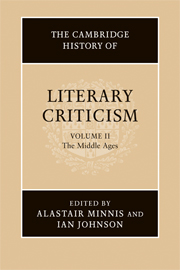Book contents
- Frontmatter
- Introduction
- I THE LIBERAL ARTS AND THE ARTS OF LATIN TEXTUALITY
- II THE STUDY OF CLASSICAL AUTHORS
- III TEXTUAL PSYCHOLOGIES: IMAGINATION, MEMORY, PLEASURE
- IV VERNACULAR CRITICAL TRADITIONS: THE EARLY MIDDLE AGES
- V VERNACULAR CRITICAL TRADITIONS: THE LATE MIDDLE AGES
- VI LATIN AND VERNACULAR IN ITALIAN LITERARY THEORY
- 20 Dante Alighieri: experimentation and (self-)exegesis
- 21 The Epistle to Can Grande
- 22 The Trecento commentaries on Dante's Commedia
- 23 Latin and vernacular from Dante to the age of Lorenzo (1321–c. 1500)
- 24 Humanist views on the study of poetry in the early Italian Renaissance
- 25 Humanist criticism of Latin and vernacular prose
- VII BYZANTINE LITERARY THEORY AND CRITICISM
- Bibliography
- Index
- References
20 - Dante Alighieri: experimentation and (self-)exegesis
from VI - LATIN AND VERNACULAR IN ITALIAN LITERARY THEORY
Published online by Cambridge University Press: 28 March 2008
- Frontmatter
- Introduction
- I THE LIBERAL ARTS AND THE ARTS OF LATIN TEXTUALITY
- II THE STUDY OF CLASSICAL AUTHORS
- III TEXTUAL PSYCHOLOGIES: IMAGINATION, MEMORY, PLEASURE
- IV VERNACULAR CRITICAL TRADITIONS: THE EARLY MIDDLE AGES
- V VERNACULAR CRITICAL TRADITIONS: THE LATE MIDDLE AGES
- VI LATIN AND VERNACULAR IN ITALIAN LITERARY THEORY
- 20 Dante Alighieri: experimentation and (self-)exegesis
- 21 The Epistle to Can Grande
- 22 The Trecento commentaries on Dante's Commedia
- 23 Latin and vernacular from Dante to the age of Lorenzo (1321–c. 1500)
- 24 Humanist views on the study of poetry in the early Italian Renaissance
- 25 Humanist criticism of Latin and vernacular prose
- VII BYZANTINE LITERARY THEORY AND CRITICISM
- Bibliography
- Index
- References
Summary
Dante Alighieri (1265–1321) reflected on matters of literature throughout his œuvre. His earliest compositions (the tenzone with Dante da Maiano, and the sonnets ‘A ciascun'alma presa e gentil core’ and ‘Com più vi fere Amor co’ suoi vincastri’ (Rime 39–47, 1, 62)), written before he was twenty, are lyric ‘correspondence’ poems, examples of a genre whose self-reflective concern with questions of literature has been amply documented. Dante's youthful rime are largely mechanical and conventional; yet, looked at in terms of his overall development and his general approach to literature, they acquire greater significance. It is suggestive that the poet should have begun writing in a ‘style’ which allowed him to establish direct textual contact with other poets and their works. From the very start, Dante was intrigued by the ‘mechanics’ of his art and by the ‘discourses’ which could accompany a literary text.
In the months before his death, Dante once again returned to the formulas of the poetic ‘debate’ (as he had on other occasions, most notably when he exchanged sonnets with Forese Donati and with Cino da Pistoia; see Dante, Rime 73–8; 110–15). Attacked in verse by the Bolognese magister Giovanni del Virgilio for having gone against traditional usage when he employed the vernacular instead of Latin, namely, a ‘low’ language instead of a ‘high’ one, to present the intellectually demanding subject-matter of the Commedia (see Dante, Egloghe I, 1–34), Dante defended his choice of language through a complex and multi-layered literary strategy. Although, especially in the first of his two replies, the poet explicitly and ironically rejected the idea that he had behaved improperly (Egloghe II, 51-4; pp. 44-5), he developed his full critique of Giovanni in a rather more subtle and implicit way: one, in fact, which underlined his poetic sensibility.
- Type
- Chapter
- Information
- The Cambridge History of Literary Criticism , pp. 559 - 582Publisher: Cambridge University PressPrint publication year: 2005
References
- 2
- Cited by

